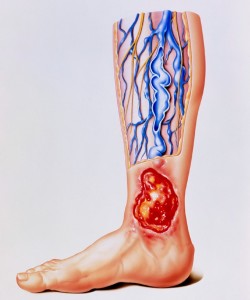 Venous Ulcers
Venous Ulcers
Venous ulcers require a two-pronged approach to treatment. The ulcer wound requires appropriate care. If it is mistaken for another kind of ulcer, local care may not be appropriate.
Sometimes antibiotics are helpful in the healing of these wounds. But the wounds won’t heal unless the abnormal back pressure in the veins is countered. This can be done with compression stockings or well-performed compression bandaging. But in the long run, it is best to identify and treat the underlying vein disease. This may involve treating the Great Saphenous Vein with the Closure procedure (endovenous radiofrequency ablation) or other veins with endovenous chemical ablation or endovenous laser (see Diagnosis and Treatment of Varicose Veins).
In some cases, the deep veins of the leg are abnormal (most frequently as a result of damage from a deep vein thrombosis, or blood clot of the deep veins) and diagnosis and treatment can be quite complicated. Most physicians have been taught that venous ulcers are nearly always a result of previous deep vein thrombosis, and usually can only be treated by life-time use of compression stockings.
What we now know, and what I see in my practice, is that most patients with venous ulcers have untreated disease of the superficial veins as the cause of their ulcer, and can be effectively treated with proper diagnosis and treatment of those veins. So, while venous ulcer is a dreaded complication of vein disease, it is still essential to have an expert evaluation with ultrasound of both the deep and superficial vein systems.
Appropriate treatment with the latest minimally invasive techniques can provide long-term healing of the ulcers, and even reversal of the skin changes.
